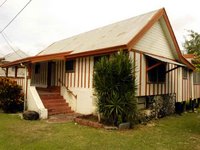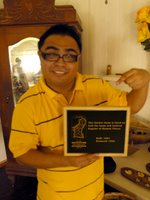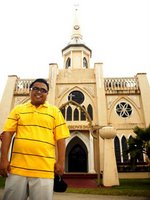 Today, we visited Tumon Bay, one of four protected marine reserves of Guam. Tumon Bay is actually the area of the hotel row which is why visitors residing in the hotels could easily access it. Our plan was to snorkel from the Ypao Beach Park.
Today, we visited Tumon Bay, one of four protected marine reserves of Guam. Tumon Bay is actually the area of the hotel row which is why visitors residing in the hotels could easily access it. Our plan was to snorkel from the Ypao Beach Park. Instead, we found ourselves going snuba diving, which is a mix of scuba diving and snorkeling since although you have the oxygen tank, the tank is floating on an inflated raft above the surface. It was a good thing Snuba, a company which offered this great activity, had clients on Ypao Beach that day. So we were able to join in. A thirty minute snuba tour around the reefs of Tumon Bay would cost you about US$65 per person.
Instead, we found ourselves going snuba diving, which is a mix of scuba diving and snorkeling since although you have the oxygen tank, the tank is floating on an inflated raft above the surface. It was a good thing Snuba, a company which offered this great activity, had clients on Ypao Beach that day. So we were able to join in. A thirty minute snuba tour around the reefs of Tumon Bay would cost you about US$65 per person.We got ourselves some underwater cameras yesterday night. It was a great deal since we got the reusable ones with flash for just US$15 at K-Mart. So you just have to change the film when it's done. So I'll post the photos of our snuba trip once I get the photos developed.
 There was a lot of marine life in the reef. Not as much as the deeper reefs but going snuba in Tumon Bay was a good introduction to scuba for a beginner like myself. The fish aren't scared of people since no one is allowed to go fishing in this protected area and they are used to people too. I think I'll try the real scuba diving one of these days since checking out the marine life was really fun! I didn't expect it to be that tiring though because when I got out of the water, I was so exhausted. My throat was dry too!
There was a lot of marine life in the reef. Not as much as the deeper reefs but going snuba in Tumon Bay was a good introduction to scuba for a beginner like myself. The fish aren't scared of people since no one is allowed to go fishing in this protected area and they are used to people too. I think I'll try the real scuba diving one of these days since checking out the marine life was really fun! I didn't expect it to be that tiring though because when I got out of the water, I was so exhausted. My throat was dry too! We had to rush and get dressed since we had to catch the rest of the group for lunch at Tony Roma's at the SM Store. Yes people... Henry Sy has landed in Guam! It was hosted by SM Store GM Tes Reyes and the marketing heads of Continental Airlines and the Guam Visitors Bureau namely Lou Sanchez and Pilar Laguana.
We had to rush and get dressed since we had to catch the rest of the group for lunch at Tony Roma's at the SM Store. Yes people... Henry Sy has landed in Guam! It was hosted by SM Store GM Tes Reyes and the marketing heads of Continental Airlines and the Guam Visitors Bureau namely Lou Sanchez and Pilar Laguana.My lunch really accelerated my food binge. Talk about American servings! I had a large serving of ribs and chicken, coleslaw and a mound fries all in one plate! And to think I had tortilla chips and salsa before the main course.
 I decided to take a nap after lunch since I didn't want to go shopping anymore plus I slept quite late the night before since I was maximizing my Internet access which was US$15 for 24 hours! So they brought me back to the hotel while the rest went shopping or were doing more interviews.
I decided to take a nap after lunch since I didn't want to go shopping anymore plus I slept quite late the night before since I was maximizing my Internet access which was US$15 for 24 hours! So they brought me back to the hotel while the rest went shopping or were doing more interviews.From the balcony of my room, I took some photos of Tumon Bay. Really great view! It's a really good thing Guam was able to take care of its environment which is why you have these really blue waters right beside high-rise hotels.
 For dinner, we met up with successful Filipino businessman Emilio Uy at Proa Restaurant. Again, another large plate for dinner. I could feel my stomach and my face expanding! Mr. Uy was the owner of a very large office supply store in Guam and was very famous for his generosity to visiting Filipinos. He even sent us some pasalubongs at the hotel.
For dinner, we met up with successful Filipino businessman Emilio Uy at Proa Restaurant. Again, another large plate for dinner. I could feel my stomach and my face expanding! Mr. Uy was the owner of a very large office supply store in Guam and was very famous for his generosity to visiting Filipinos. He even sent us some pasalubongs at the hotel. We had to rush back to the hotel since Probe had to interview Cueshe, a popular Filipino band, who was in Guam for a week for some gigs. Cheche Lazaro did the interview and we got to listen in. We found how they started in Cebu and the gamble they took by coming over to Manila without any assurance of gigs and all; how they lived in a single apartment, living on canned foods and noodles. Well, obviously their gamble paid off.
We had to rush back to the hotel since Probe had to interview Cueshe, a popular Filipino band, who was in Guam for a week for some gigs. Cheche Lazaro did the interview and we got to listen in. We found how they started in Cebu and the gamble they took by coming over to Manila without any assurance of gigs and all; how they lived in a single apartment, living on canned foods and noodles. Well, obviously their gamble paid off.After the interview, I went up again to my room since I wanted to maximize the remaining minutes of the Internet connection. Haha! We leave for Saipan tomorrow.
OT: The M/S Nippon Maru is now docked in Manila. And I missed the SSEAYP reunion on board the ship! Oh well! I will have to wait for 2008 since it's not docking in Manila next year. Thanks to SSEAYP International Philippines for the SIP National Award for Arts & Culture. I apologize for not being there to receive the award personally since I'm still working here. Thanks again!
Photo credits: Karlo de Leon who took most of my photos, Jodi Madridejos and Cheche Lazaro.


























